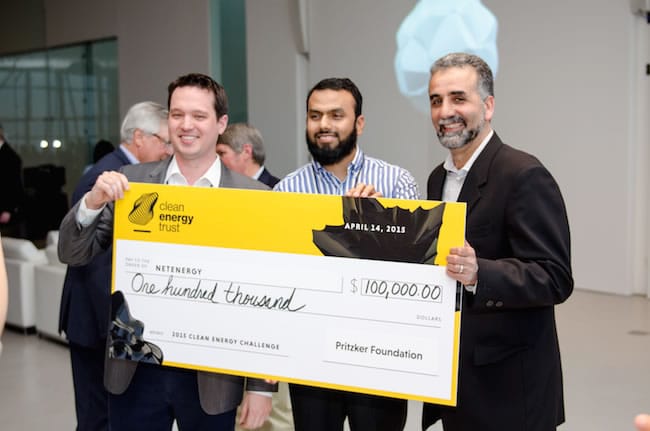“We are building a thriving energy innovation ecosystem in the Midwest,” is the decree proudly crowning the front page of the Chicago-based Clean Energy Trust’s website. And as this year marked the fifth for its flagship Clean Energy Challenge, the “we” in focus extended to the participating clean-tech business startup entrepreneurs as well as prominent green industry leaders lending keynote addresses to share the secrets of their success and offer sound advice to newcomers determined to arrive at the fruitful intersection of “startup investment, technology commercialization, and energy policy” for which the nationally-acclaimed Clean Energy Trust specializes. $1,000,000 was appropriated and divided among the 10 winning startups with amounts received depending on the distinction of the specific awards. Here, we’ll take a look at the very best in the business of energy efficiency.
WINNER
Award: Pritzker Foundation Prize ($100,000)
Company: NETenergy (University of Chicago, IL)
For: Thermal Storage
Impressively, NETenergy is an energy service provider that resulted from a student team creation at the University of Illinois. Deploying smart energy storage and management technologies, NETenergy reduces energy consumption by way of their signature intelligent thermal storage software. By utilizing “phase change composites,” cold energy is stored in the form of “latent heat” and is distributed only as needed. This enables users to shift their A/C energy consumption to simply more economical during off-peak hours. Savings of over 30% can be attained with NETenergy.

WINNER
Award: Wells Fargo Prize ($100,000)
Company: Igor (Johnston, IA)
For: Smart Building & Devices
“Power Over Ethernet” is the mantra boast ed by Igor to illustrate their uniquely efficient approach to lighting management. By using the Igor system, customers are able to reduce energy consumption, micromanage how their LED lighting is being used, and simplify their lighting system’s installation. The room in which the Igor lighting, sensor and data platform may be installed can vary in size, but the level of control placed the hand of the user is always optimal. With a user-friendly interface, the Igor application allows you to freely and wirelessly adjust lights, sensors, and such as needed for each specific space. By licensing its services to a host of manufacturers, Igor has achieved “80% savings toward installation and 60% savings toward energy.”

WINNER
Award: ComEd Female Founder Prize and Clean Energy Prize Fund ($75,000)
Company: Design Flux Technologies (Maple Heights, OH)
For: Energy Storage
Two electrical engineering students at the University of Akron spurred the genesis of Design Flux Technologies. Uniting out of dissatisfaction with the conventions and complexities of standard energy storage systems, the duo collaborated with the aim of devising a solution to a standard that was inefficient in its function and mediocre in terms of sustainability. And the result was an innovation that was a first of its kind. The conceptualization and patenting of “Cognicell,” a power management system implemented through software control algorithms, soon became the bedrock of the Design Flux Technologies brand. Through using their signature Cognicell system, “predictive software algorithms” are employed to systematically control all battery pack functions. Among resultant stats the company has enjoyed are a 50% decrease in battery maintenance costs, a 30% increase in battery life, and a 40% increase in energy efficiency.

WINNER
Award: US Department of Energy Student Prize ($50,000)
Company: FGC Plasma Solutions (Case Western Reserve University, OH)
For: Advanced Transportation/Fuel Efficiency
Jet engine fuel is not an uncommon target of criticism in debates concerning environmental woes. However, a student team at Case Western Reserve University is presently in the process of perhaps absolving users of this transit luxury of guilt. The student-led FGC Plasma Solutions are redrafting the process of fueling jet engines by applying plasma to modify the combustion reaction. This concept isn’t necessarily new, but research of this method has faced difficulty advancing this process beyond mere lab tests and studies. FGC, on the other hand, has taken the initiative of developing a new, plasma-integrated fuel nozzle that will improve not just jet-engine efficiency, but also fuel economy and safety.

